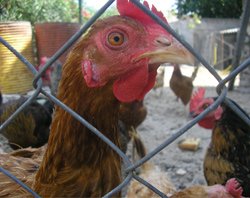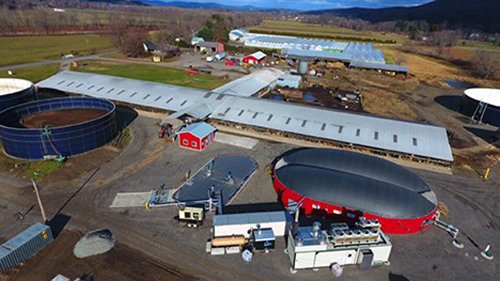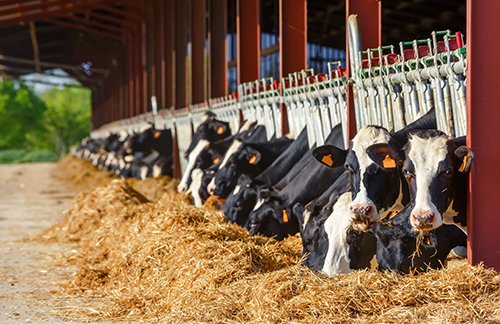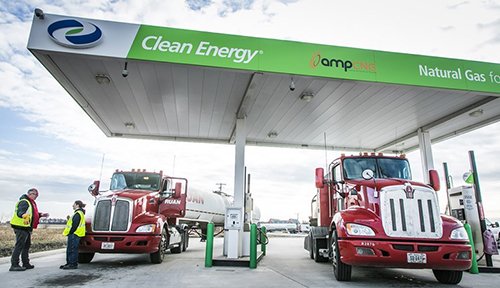Frequent Questions about Livestock Biogas Projects
Frequent questions are grouped by topic. Click on a question to view the answer.
Anaerobic Digestion
- What is anaerobic digestion?
- How does an anaerobic digester work?
- Are farmers using anaerobic digesters in the United States?
- How do I estimate methane emissions reductions from an anaerobic digestion system?
- Are anaerobic digester projects on farms financially viable?
Benefits of Anaerobic Digestion
- What are the economic and social benefits of anaerobic digesters on farms?
- What are the environmental benefits of anaerobic digesters on farms?
- What other manure management practices reduce methane emissions?
- How does biogas produced from anaerobic digestion compare to other forms of renewable energy?
Environmental Justice
- What is environmental justice?
- How can environmental justice be incorporated into decisions about siting and using anaerobic digester systems?
- Is it safe to live near an anaerobic digester?
Project Planning and Operation
- Do anaerobic digesters have to be located on a farm?
- How do I know if anaerobic digestion makes sense for my farm?
- Can anaerobic digestion projects work on small farms?
- What do I need to know about permitting an anaerobic digester?
- How are potential hazards addressed in the design and operation of an anaerobic digester?
- Can biogas be piped or transported for sale?
- How can my project participate in California’s Low Carbon Fuel Standard (LCFS) program?
- How can my project apply for a RIN (Renewable Identification Number)?
Additional Resources
Anaerobic Digestion
1. What is anaerobic digestion?
Anaerobic digestion (AD) is a process through which bacteria break down organic matter—such as animal manure, wastewater biosolids, and food wastes—in the absence of oxygen. As the bacteria break down (or “digest”) the waste, they generate biogas. The biogas generated is mostly made of methane, the primary component of natural gas.
2. How does an anaerobic digester work?
Anaerobic digestion is a process through which bacteria break down organic matter—such as animal manure, wastewater biosolids, and food wastes—in the absence of oxygen. Anaerobic digestion (AD) for biogas production takes place in a sealed vessel called a reactor, which is designed and constructed in various shapes and sizes specific to the site and feedstock conditions (learn more about AD system design and technology). These reactors contain complex microbial communities that break down (or “digest”) the waste and produce biogas as well as “digestate” (which refers to the solid and liquid material end-products of the AD process) which are then discharged from the digester.
“Biogas” is a gaseous mix of methane, carbon dioxide, water vapor, and other trace gases. Capturing biogas from cattle, hog, and poultry manure using an anaerobic digester can reduce greenhouse gas emissions and provide a source of renewable energy. Recovered biogas can be an energy source for electricity, heating, or transportation fuel.
Digestate is the solid and liquid effluent remaining after the anaerobic digestion process. Both the solid and liquid portions of digestate can be used in many beneficial applications, such as animal bedding (solids), nutrient-rich fertilizer (liquids and solids), a foundation material for bio-based products (e.g., bioplastics), organic-rich compost (solids), and/or simply as soil amendment (solids), the latter of which may include the farm spreading the digestate on the field as fertilizer.
Additional resources:
- How does anaerobic digestion work?
- Illustration of How Anaerobic Digesters Work
- Recovering Value from Waste: Anaerobic Digester System Basics
3. Are farmers using anaerobic digesters in the United States?

Yes! Anaerobic digesters work best at farms that collect large amounts of manure as a liquid or slurry on a daily basis. AgSTAR estimates that biogas recovery systems are technically feasible (i.e., based on the size of their current operations) at over 8,000 U.S. dairy and hog operations. Use of anaerobic digestion at poultry and beef operations is also continuing to grow as new technologies enter the market. Although projects at poultry and beef farms may be technically feasible, their economic feasibility can vary from site to site.
As of 2024, there are over 400 anaerobic digesters operating at livestock farms in the United States and more than 70 digester projects in the construction phase. Learn more about these projects:
- Livestock Anaerobic Digester Database
- Interactive Digester Location Map
- Stories from the Farm
- Data and Trends
4. How do I estimate methane emissions reductions from an anaerobic digestion system?
The U.S. Environmental Protection Agency (EPA) created the Anaerobic Digestion Screening Tool (ADST) to help project developers, government agencies, financial institutions, and other stakeholders assess whether an anaerobic digestion (AD) project is technically and economically feasible at their site. This tool was developed by EPA for use at farms in the United States and globally as part of the Biogas Toolkit shared through the Global Methane Initiative. This spreadsheet-based tool provides methane emissions reduction estimates for a variety of feedstocks, including organic municipal solid waste, livestock manure, agriculture residues, and wastewater. If you are considering implementing an AD project, you can download the tool and fill in data about your farm. It will calculate projected methane emissions reductions, annual biogas and digestate production, and recommend potential end uses of the biogas.
If you decide to move forward with your project, or already have an existing system, you can estimate the methane emissions reduction from anaerobic digester(s) using a protocol that AgSTAR developed. The protocol covers various types of digesters and waste streams and offers four levels of evaluation based on your farm’s capacity and available resources. For each of the levels, you will need to collect regular data on the physical and chemical characteristics of the AD system’s inputs and outputs. This data, along with general information on your farm’s size and operations, can then be used in the calculations discussed in the protocol.
The tool and protocol can be accessed here:
- Anaerobic Digestion Screening Tool
- Protocol for Quantifying and Reporting the Performance of Anaerobic Digestion Systems for Livestock Manures
5. Are anaerobic digester projects on farms financially viable?
Yes! Successful and profitable projects have been implemented on dairy, swine, and poultry farms of varying sizes and types. There are numerous factors that will dictate the likelihood of a profitable project. Changes in input factors, even those that may appear subtle, can have a significant impact on the likelihood of project success. Therefore, careful, detailed planning is required.
One of the biggest obstacles to the widespread adoption of on-farm anaerobic digestion is project cost. To help pay for up-front capital costs, anaerobic digester operators may use several funding sources, including grants, cash reimbursements, loan guarantees, industrial revenue bonds, private funding, and other cost-sharing agreements. Many AD/biogas system projects apply for and receive funding from a combination of these resources. In addition, up-front capital costs may be offset by revenue generated from the digester’s operation. These include the sale of electricity, renewable natural gas (RNG), transportation fuel and other coproducts—like soil amendments, compost, and fertilizer—that are generated by the digester system.
Financial viability is dependent on many factors; it is essential that farms consider all capital, operation, and maintenance costs, financing options and financial assistance, and potential revenue streams when evaluating anaerobic digester projects. AgSTAR has developed resources to support farmers with planning and financing projects:
- Introduction to financing anaerobic digestion projects
- Funding On-Farm Anaerobic Digestion Fact Sheet
- Project Development Handbook, Chapter 6: Economic and Financial Factors
- Risk Analysis Checklist
Benefits of Anaerobic Digestion
1. What are the economic and social benefits of anaerobic digesters on farms?
There are several economic benefits generated from operating anaerobic digestion systems on farms. New revenues can be created for the farms, thereby diversifying the farms’ business models. For example, digesters can provide a new source of income by selling biogas-based renewable energy and receiving tipping fees for co-digestion feedstocks.
New revenue can also be generated from the sale of digestate-derived products such as treated digestate for use as animal bedding or as a peat moss replacement to increase soil quality. Nutrients present in the manure remain, but nitrogen and phosphorus are transformed from organic forms to inorganic or mineralized forms in the digestion process. Inorganic or mineralized nutrients allow for increased plant availability (i.e., nutrients are more easily absorbed through the roots of the plants for plant growth), which may minimize or offset the use of fertilizers. Further processing of digestate, including concentration of nutrients, allows for potential off-farm sales. Maximizing co-product value increases farmers’ resiliency from the uncertainty of commodity market price fluctuations.
As farmers look for innovative ways to economically and environmentally manage their manure, anaerobic digestion systems also create more opportunities for rural economic growth. Constructing and operating digesters offers the opportunity to create new local jobs as do new value-added products, which require production and process facilities separate from the anaerobic digestion facility.
The addition of anaerobic digesters may also improve farms’ relationships with surrounding communities. The construction and management of anaerobic digestion systems can stimulate new economic opportunities in local communities, including new jobs. Construction and management of AD systems and the resulting supply chain of biogas increases economic activity for farms. Additionally, manure digester systems can significantly reduce unpleasant odors and improve local air quality. In some cases, anaerobic digesters create opportunities for local agro-tourism, where people can visit nearby farms to learn more about topics such as environmental issues, agricultural practices, and where their food comes from. By working closer with the community and limiting negative impacts, farmers are in turn more likely to be supported during any future expansion.
Additional information can be found on AgSTAR’s benefits of anaerobic digesters webpage.

2. What are the environmental benefits of anaerobic digesters on farms?
Methane emissions from manure management systems are directly reduced using anaerobic digester systems that collect and destroy the methane generated. In addition, when the biogas produced by the anaerobic digester system is used for energy, methane emissions are indirectly reduced from avoided fossil fuel use. Anaerobic digestion systems emit less methane compared to uncovered anaerobic lagoons because the methane emissions are captured and destroyed or utilized.
Based on AgSTAR’s Data and Trends web page, farm-based AD/biogas systems reduced GHG emissions by 10.43 million metric tons of CO2 equivalent (MMT CO2e) in 2022 by reducing on-farm direct GHG emissions and avoiding emissions by replacing fossil fuels. This is equivalent to the CO2 emissions produced by over 2,480,000 passenger cars in one year, according to the EPA’s Greenhouse Gas Equivalencies Calculator. These digesters generated the equivalent of 2.42 million megawatt-hours (MWh) of electricity; enough to power more than 131,000 homes annually.
Beyond direct methane emissions mitigation, anaerobic digestion systems convert waste products that are considered a liability into beneficial resources. Some farms with anaerobic digester systems will “co-digest” farm waste with local food waste, which generally has a higher methane production potential. Avoiding these methane emissions and harnessing this energy resource has profound and long-term environmental value. Anaerobic digestion plays a crucial role in achieving the goals set forth in the U.S. National Strategy for Reducing Food Waste and Loss. Recycling organic waste offers the opportunity to recover nutrients and create healthy soils, in a way that also promotes environmental justice through local community engagement. Properly managed organics recycling is essential to building a more circular economy, encompassing actions that regenerate nature and reduce landfill and farm methane emissions.
3. What other manure management practices reduce methane emissions?
There are several common manure management practices that can reduce methane emissions, such as daily spread, pasture-based management, and composting. Visit AgSTAR’s Practices to Reduce Methane Emissions from Livestock Manure Management page for more information.
4. How does biogas produced from anaerobic digestion compare to other forms of renewable energy?
Biogas produced from anaerobic digestion systems, sometimes referred to as “renewable natural gas,” or “RNG,” provides a resource that is independent of weather and seasons. Biogas produced from anaerobic digester systems can be generated around the clock (“24/7”) because livestock continuously generate manure, the feedstock that creates methane, thus enabling it to contribute to “baseload” renewable energy generation.
Anaerobic digestion systems can also produce “dispatchable power,” which is power generated when it is most needed to meet demand. This “peak power” can be of great monetary value as the energy value can be significantly higher during peak versus off-peak periods. Biogas generated from anaerobic digestion systems can be stored to be available for use during times of peak demand. For example, biogas can be stored in low-cost inflatable covers or cells until needed.
Environmental Justice
1. What is environmental justice?
The U.S. Environmental Protection Agency (EPA) defines environmental justice as the fair treatment and meaningful involvement of affected individuals in government decision-making processes to ensure all people, regardless of race, income, ethnicity, national origin, or level of physical ability, are protected from a disproportionate share of adverse environmental and health conditions and have equal access to a healthy environment.
2. How can environmental justice be incorporated into decisions about siting and using anaerobic digester systems?
Anaerobic digester systems that produce biogas as a renewable fuel can have multiple benefits for local communities, including improved air quality, odor reduction, economic benefits, diversification of farm income, and pollution prevention.
However, nearby communities may have concerns about such systems, and it is critical to conduct community outreach before siting and developing a new AD/biogas project. The local community needs to understand how the project is designed, especially those that require public participation during project zoning and siting cases.
Providing information about anaerobic digester systems, including the benefits they can provide, may help allay the concerns of the members of the community most likely to be affected. Project developers should engage early and often with members of the community to provide information about AD/biogas systems and ensure buy-in and approval from the community.
Additional AgSTAR resources include:
- Considering Environmental Justice When Designing and Implementing a Renewable Natural Gas Project
- Project profile of a Wisconsin digester project implemented to improve local water quality
- Project Development Handbook, Chapter 10: Public and Community Outreach
3. Is it safe to live near an anaerobic digester?
Yes. Anaerobic digesters provide many benefits and can decrease some of the risks associated with manure spills near a farm. Benefits include reduced odors, diminished potential for nitrogen and phosphorus run-off, and decreased pathogen levels in the digestate.
Additionally, there are federal regulations and state permitting requirements for anaerobic digesters. The permits protect air and water quality and may also include requirements for solid waste and energy production facilities. These measures are designed to protect the health and safety of both the farmers and the public.
Project Planning and Operation
1. Do anaerobic digesters have to be located on a farm?

No. While many operating anaerobic digester systems in the United States are located on farms, digesters can also be located off-site. Digesters that rely on feedstocks from multiple sources (e.g., co-digestion) or locations may be centrally located to minimize the transportation cost of the feedstocks. Additionally, anaerobic digester systems are often employed in other waste streams such as landfills or wastewater facilities for methane gas capture.
Note that different feedstocks can result in different volumes and compositions of the coproducts created by the system. For example, food processing waste may contain excess nutrients like nitrogen. As a result, anaerobic digesters that use multiple feedstocks may be subject to different permitting or regulatory requirements. Also, some incentives and net metering laws may also require a portion of the digester feedstock to come from manure.
- AgSTAR’s Guidelines and Permitting page provides information on state and federal requirements for anaerobic digestion and co-digestion
-
Chapter 6.4 of AgSTAR’s Project Development Handbook discusses possible owner and operator models that can be used in off-farm digester projects
2. How do I know if anaerobic digestion makes sense for my farm?
To determine if an anaerobic digester is right for your farm, you need to consider: how manure is handled at your facility, the frequency of manure collection, the options available for using the recovered biogas, applicable guidelines, and your potential return on investment.
AgSTAR has developed comprehensive resources to help farmers determine if anaerobic digestion is right for them:
- Is anaerobic digestion right for you?
- What guidelines apply to anaerobic digesters?
- Project Planning and Financing
- Project Development Handbook, Chapter 6: Economic and Financial Factors
- Project Development Handbook, Chapter 7: Screening and Feasibility Studies
3. Can anaerobic digestion projects work on small farms?

Yes. The majority of anaerobic digesters in the United States are on larger farms (above 1,000 cows or 5,000 hogs), but many smaller-scale facilities have successfully implanted anaerobic digestion systems. To be a good candidate for anerobic digestion, small farms must produce frequently-collected manure as a liquid, slurry, or semi-solid at a single location. This is essential for effective operation of the digester; manure that is too dry is not easily digested compared to manure in a liquid or slurry. In addition, farms considering an anaerobic digestion system should have a relatively constant year-round animal population and a consistent quantity and quality of manure.
Anaerobic digester projects on smaller farms require more careful planning and favorable economic and financial conditions than at larger farms that can benefit from economies of scale. Often, regional market conditions, government incentives (local or state), or other conditions may allow for successful implementation on smaller scale farms. Anaerobic digesters can be worth the investment at a small farm depending on the revenue received from the sale of products (e.g., biogas and digestate) or costs avoided (e.g., energy, fertilizer, bedding). Smaller farms may also benefit from co-digestion of other feedstocks to boost biogas production and increase the energy generated from the project. Developing a business model that meets the needs of the farm and investors is key to determining if a digester can work on smaller farms.
Additional resources:
- AgSTAR’s project profile of Barstow’s Longview Farm, which has a herd size of 250 cows, provides a great example of anaerobic digestion success on a smaller farm
- The Minnesota Project, which provides information on digester opportunities for mid-sized farms, is a good resource for small farms interested in anaerobic digestion
- Chapter 6 of AgSTAR’s project development handbook provides detailed guidance on different business models for anaerobic digestion systems
4. What do I need to know about permitting an anaerobic digester?
Anaerobic digestion and co-digestion systems may be subject to federal and/or state air, solid waste, and water permitting requirements. In addition, local permits could be required for construction, zoning, and stormwater management. Always check with your local and state regulatory agencies to determine the permits required for your project. AgSTAR has developed resources to help farmers navigate the permitting process:
- AgSTAR’s Guidelines and Permitting page provides information on state and federal requirements for anaerobic digestion and co-digestion
- Chapter 9 of AgSTAR’s Project Development Handbook provides detailed guidance on the permitting process and considerations
5. How are potential hazards addressed in the design and operation of an anaerobic digester?
There are many ways to reduce risk when designing and operating an anaerobic digester. These include both common-sense measures to prevent accidents and specific design measures to manage exposure to confined biogas. As with any energy system, it is important to design and maintain the system properly. Also, always follow basic safety precautions and good work practices to reduce potential risk.
For example, to avoid the threat of fire or explosion, there should never be open flames near the digester. All equipment used around the digester should be non-sparking and explosion-proof.
To avoid the threat of asphyxiation, the system should be designed so that it is not necessary to enter the confined manure storage space for maintenance or other reasons. If it is necessary to enter the confined space, workers should wear protective equipment, including a self-contained breathing apparatus.
There are several resources that further address safety considerations:
- Chapter 10 of AgSTAR’s Anaerobic Digester/Biogas System Operator Guidebook contains comprehensive guidelines to foster and increase health and safety considerations regarding anaerobic digester systems
- Cornell University produced a guide for conducting a safety walk-through on a farm
- Penn State Extension offers educational resources on manure pit safety
6. Can biogas be piped or transported for sale?

Yes. Biogas can be processed to remove impurities and sold. When processed and compressed, biogas can be transported via pipeline—just like natural gas.
7. How can my project participate in California’s Low Carbon Fuel Standard (LCFS) program?
The California Air Resources Board (CARB) Low Carbon Fuel Standard (LCFS) is designed to decrease the carbon intensity of California's transportation fuel and provide an increasing range of low-carbon and renewable alternatives, which together reduce petroleum dependency and achieve air quality benefits. Using fuel pathway-based crediting, all transportation fuels need a carbon intensity (CI) score to participate in the LCFS, and the fuel type dictates which process is used to determine that CI. Biogas derived from dairy and hog manure that is upgraded and used as CNG vehicle fuel has, by far, the lowest carbon footprint or carbon intensity (CI) of any transportation fuel.
More information on LCFS:
8. How can my project apply for a RIN (Renewable Identification Number)?
Anaerobic digesters may be eligible to generate Renewable Identification Numbers (RINs) under the Renewable Fuel Standard (RFS) program if the biogas is produced from qualifying renewable biomass and used as a transportation fuel.
Additional resources:
- Renewable Fuels: Compliance Help provides more information about the RFS, how to register an approved biogas pathway to generate RINs, and how to petition for a new biogas pathway to generate RINs
Additional Resources
1. Who can I contact to learn more about anaerobic digestion projects?
- AgSTAR can help you learn more about EPA’s agricultural methane emission reduction program
- AgSTAR Partners -- including state and non-governmental organizations – can help you learn about permitting requirements, incentives and emerging research
- AgSTAR's Stories from the Farm provide insights from operating anaerobic digesters
- International activities highlight progress in deploying anaerobic digestion technology all around the world
- The Vendor Directory connects you with anaerobic digester designers, project developers, energy service providers, equipment manufacturers and distributors, and commodity organizations
- USDA and DOE provide resources and information to support anaerobic digester projects
